








A documentary by Gaurav Jani
94 minutes
28th Dec 2008 ; 5.45 pm
Ashwin Hospital Auditorium
Call : 94430 39630
http://konangalfilmsociety.blogspot.com/
This is a documentary film about filmmaker Gaurav Jani's solo motorcycle journey from Mumbai to one of the remotest places in the world, the Changthang Plateau in Ladakh, bordering China. The film is even more extraordinary for the fact that Jani was a one-man crew who loaded his 200 kg motorcycle with over 100 kgs of equipment/supplies and set off on a journey to one of the world's most difficult terrains.

“I wanted to make a documentary series about the romance of travel in India: Five bikers on a two-year ride without a proper film unit or a plan. Without a pre-planned screenpl ay and film unit, the documentary was to capture the real experience of travel. “Let’s just go there and take it from there”, like a lot of us who travel footloose without a plan. The film was to capture the little moments that stay with us for a lifetime; the places, the people, the highs and lows of travel.

With minimum luggage, I started off from Vivek Sharma's house in Delhi. The maximum amount of space was occupied by the camera box and camera accessories. The heaviest bag had the bike spares and tools. Once on the road, each time I had to take a shot, I had to untie the camera bag and tripod, remove the camera, tie the camera bag back onto the bike, set the frame, wear the helmet, ride away from the camera, come back to unpack the camera bag on the bike and pack the camera and tripod back onto the bike. Sounds like a lot of work but any film-maker would go to any length to get a good shot.

There are two shots in the film where I have not operated the camera. One shot is in the trailer where the camera pans while I am riding. That shot was taken by a cameraman of the Zee News channel.

Zee News was doing a feature on paragliding near Rohthang pass at Manali and they too were using the same Panasonic camera. I actually wanted to inquire from the cameraman on what all precautions I should take while taking shots in sub-zero temperatures. Second shot was taken by a Royal Beast (a Royal Enfield club from Delhi) member whom I had met en route.

I wanted the Zee News shot in the film as it was the only shot where the camera moves while I am riding, But quite a few people after seeing the shot thought that my claim of filming my own journey was bogus, so in the DVD cut, we have replaced that shot with me riding past the milestone of Rohthang pass.

Filming my own journey on the high altitude region was tough physically, but mentally it was satisfying. Any first-time director would be nervous on the sets, crew and cast waiting for his directions. But for Riding solo... there was no one to judge me or look at me for further instructions. I was filming without any plan or schedule and most importantly, I had complete freedom. A perfect scenario for a first time director . “
- filmmaker Gaurav Jani


Gaurav, also known as Jani, Bhatku (wanderer) or GJ, directs films for Dirt Track Productions. Riding Solo To The Top Of The World is his debut film. Gaurav is a travel freak and a biker. He likes to collect antiques, but doesn’t have the money for it! He is also the founder member of 60kph, Motorcycle Travel Club India. Gaurav functions as a one-man film unit to capture the true essence of travel and it’s highs and lows. He neither believes in planning nor research, preferring instead to trust his instincts and firm resolve. Sometimes things work out the way he wants and sometimes they bomb, but he doesn’t change. He likes to keep things simple and basic, letting his heart rule over his head.
Phone : +91 9833013039
Email : gaurav[at]dirttrackproductions[dot]com









FILM FESTIVAL

Screening of two rare classics of the Italian master
Shoeshine and Brief Vacation
14th December 2008 ; 10 am to 6 pm
Call : 94430 39630
VITTORIA DE SICA
 Sica built a remarkable film career that spanned half a century.
Sica built a remarkable film career that spanned half a century.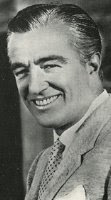 was a mature, perceptive, and deeply human work about the impact of adult folly on a child's innocent mind. The film marked the beginning of De Sica's collaboration with author and screenwriter Cesare Zavattini, a creative relationship that was to give the world two of the most significant films of the Italian neorealism movement, "Shoeshine" and "The Bicycle Thief."
was a mature, perceptive, and deeply human work about the impact of adult folly on a child's innocent mind. The film marked the beginning of De Sica's collaboration with author and screenwriter Cesare Zavattini, a creative relationship that was to give the world two of the most significant films of the Italian neorealism movement, "Shoeshine" and "The Bicycle Thief." A master at portraying stark realities of poverty while retaining glimmers of hope and humanity, De Sica constructs a poignant yet unsentimental film that compels audiences to weep openly by the end.
A master at portraying stark realities of poverty while retaining glimmers of hope and humanity, De Sica constructs a poignant yet unsentimental film that compels audiences to weep openly by the end. Vittorio De Sica creates a l ucid, sincere, and impassioned portrait of poverty, corruption, and desolation in Sho eshine. From the introductory images of ubiquitous American soldiers at an economically (a n d perhaps, militarily) ravaged town (note their presence at the sanctuary of the horse rental stable as well as the high-traffic streets where the shoeshine boys eke out a meager living from their almost exclusively foreign patrons), De Sica establishes a recurring metaphor for the pervasive external, environmental factors that invariably exert an influence (if not govern) Giuseppe and Pasquale's lives that exist beyond their control.
Vittorio De Sica creates a l ucid, sincere, and impassioned portrait of poverty, corruption, and desolation in Sho eshine. From the introductory images of ubiquitous American soldiers at an economically (a n d perhaps, militarily) ravaged town (note their presence at the sanctuary of the horse rental stable as well as the high-traffic streets where the shoeshine boys eke out a meager living from their almost exclusively foreign patrons), De Sica establishes a recurring metaphor for the pervasive external, environmental factors that invariably exert an influence (if not govern) Giuseppe and Pasquale's lives that exist beyond their control.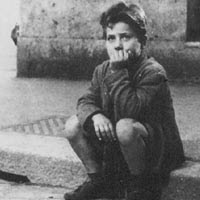 rnal force - the "outside gentleman" that the fortune teller foretells - that serves, not only as an oblique reference to the presence of Allied occupation forces in postwar Italy, but also as a representation of th e country's sentiment over their ambivalence and inutility towards the direction and scope of the reconstruction in their own country. Moreover, Pasquale's orphaning during the war and the status of Giuseppe's family as refugees forced to share a single room at a multi-family boarding house further underscore the boys' (and, in turn, the country's) sense of transience, dislocation, and impotence over their own plight and the determination of their future. It is through this systematic disillusionment that the indelible bookend image of the two friends and their beloved white horse becomes, not a euphoric expression of unbridled freedom, but a desperate, resigned rejection of its severe, inscrutable, and dehumanizing course.
rnal force - the "outside gentleman" that the fortune teller foretells - that serves, not only as an oblique reference to the presence of Allied occupation forces in postwar Italy, but also as a representation of th e country's sentiment over their ambivalence and inutility towards the direction and scope of the reconstruction in their own country. Moreover, Pasquale's orphaning during the war and the status of Giuseppe's family as refugees forced to share a single room at a multi-family boarding house further underscore the boys' (and, in turn, the country's) sense of transience, dislocation, and impotence over their own plight and the determination of their future. It is through this systematic disillusionment that the indelible bookend image of the two friends and their beloved white horse becomes, not a euphoric expression of unbridled freedom, but a desperate, resigned rejection of its severe, inscrutable, and dehumanizing course. BRIEF VACATION
BRIEF VACATION In movies like "Shoeshine" and "Bicycle Thief" he told the stories of poor people trying to survive in a system geared up to manhandle them. His films grew slicker and more commercial by the 1960s, but he never lost his gift or his heart, and there were masterpieces like "The Garden of the Finzi-Continis" (1972) and now this final return to a working-class subject.
In movies like "Shoeshine" and "Bicycle Thief" he told the stories of poor people trying to survive in a system geared up to manhandle them. His films grew slicker and more commercial by the 1960s, but he never lost his gift or his heart, and there were masterpieces like "The Garden of the Finzi-Continis" (1972) and now this final return to a working-class subject.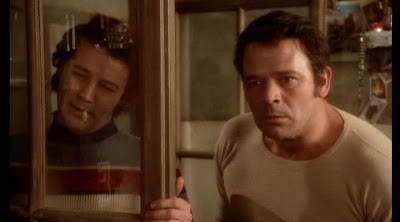
It's a "woman's picture" of the new sort, the kind in which women make up their own minds and make their own mistakes. His heroine, Clara (a luminous performance by Florinda Bolkan), is harassed and bone-tired and driven to shouting things like "I'd do better as a whore" while she faces the bathroom mirror at dawn. But she has resources she never dreamed she owned.
She leads a grim existence as a factory worker. Her husband has been hit by a motorcycle and is laid off with a broken leg. Her brother-in-law spies on her and her mother-inlaw spits on her. She's been diagnosed as a tuberculosis victim and sent to a sanitorium in the mountains, courtesy of the National Health Service. And now she has met a young man who is desperately in love with her.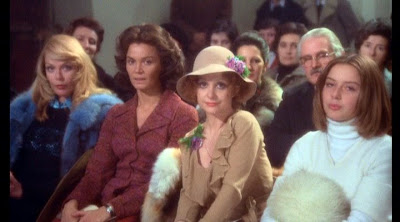
This is a woman who tells her husband it will take the police to get her back to
For the screenplay of "A Brief Vacation," de Sica returned to his old collaborator Cesare Zavattini, the man who wrote "Bicycle Thief" and "Shoeshine." It's as if, at 73, he wanted to touch base again in case this was going to be his last film.
(Source : http://rogerebert.suntimes.com)
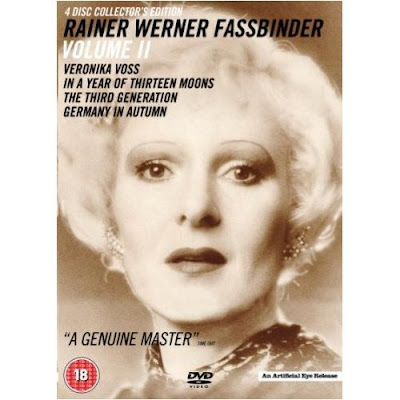
 VERONIKA VOSS was the next-to-last film made by Rainer Werner Fassbinder, who died on June 10, 1982 in Munich on account of a fatal combination of drugs and alcohol. It tells a story of a German actress, famous in the 1940s, who tried to revive her flagging career with alcohol and drugs, and fell into the hands of a sadistic woman doctor who provided the drugs as a means of controlling rich patients. The film is based on the life of Sybille Schmitz, "the German Garbo," who starred in many glossy postwar West German films before becoming addicted to drugs and killing herself in the late 1950s.
VERONIKA VOSS was the next-to-last film made by Rainer Werner Fassbinder, who died on June 10, 1982 in Munich on account of a fatal combination of drugs and alcohol. It tells a story of a German actress, famous in the 1940s, who tried to revive her flagging career with alcohol and drugs, and fell into the hands of a sadistic woman doctor who provided the drugs as a means of controlling rich patients. The film is based on the life of Sybille Schmitz, "the German Garbo," who starred in many glossy postwar West German films before becoming addicted to drugs and killing herself in the late 1950s.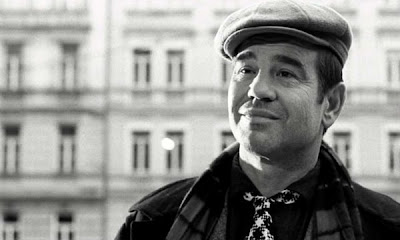 VERONIKA VOSS is the third film in his trilogy about the West German "economic miracle" of the 1950s and 1960s; the other two films were THE MARRIAGE OF MARIA BRAUN and LOLA.
VERONIKA VOSS is the third film in his trilogy about the West German "economic miracle" of the 1950s and 1960s; the other two films were THE MARRIAGE OF MARIA BRAUN and LOLA.
 It gives us a heroine who, at one time in her career, stood for the sort of sophisticated, chic sexuality associated with Marlene Dietrich. But by the time we meet Veronika Voss, she can't even pull herself together to do a tiny scene in a movie. She seeks comfort from strangers. She is hopelessly addicted to drugs, and is the captive of a psychiatrist who enjoys having a fallen star around the office.
It gives us a heroine who, at one time in her career, stood for the sort of sophisticated, chic sexuality associated with Marlene Dietrich. But by the time we meet Veronika Voss, she can't even pull herself together to do a tiny scene in a movie. She seeks comfort from strangers. She is hopelessly addicted to drugs, and is the captive of a psychiatrist who enjoys having a fallen star around the office.
 The elaborate camera moves and the great attention to decor are just right for the performances., which come in two styles: stylized and ordinary. Veronika Voss is elegant even in her degradation, but she is surrounded here by plainer folks like Robert, the sportswriter she picks up in a cafe. There are times during the movie when we can almost see everyday, ordinary postwar Germany picking its way distastefully through the smelly rubble of pre-war decadence.
The elaborate camera moves and the great attention to decor are just right for the performances., which come in two styles: stylized and ordinary. Veronika Voss is elegant even in her degradation, but she is surrounded here by plainer folks like Robert, the sportswriter she picks up in a cafe. There are times during the movie when we can almost see everyday, ordinary postwar Germany picking its way distastefully through the smelly rubble of pre-war decadence.


